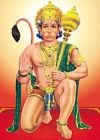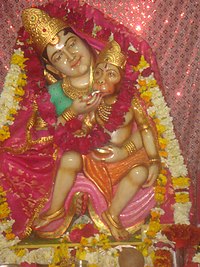Hanuman Jayanti is the birthday of Lord Hanuman celebrated on Chaitra Purnima or the Full Moon day in Chaitra month in many parts of North Indian states. Hanuman Jayanthi 2011 date April 18. Chaitra Purnima is also known as Maha Chaitri. Hanuman Jayanthi date in May 2011 (in Vaishakha masam). In Andhra Pradesh and Karnataka, Hanuman Jayanthi is observed on Vaishakha Bahula Dasami which falls during May – June months. In Andhra Pradesh and Karnataka states, Chaitra Pournami is celebrated as Hanuman Vijayotsavam.
In Gujarat and some other regions in North India, Ashwin Krishna Chaturdasi (the day before Diwali) is popularly observed as Hanuman Jayanti. In Tamil Nadu and Kerala, devotees celebrate Hanuman Jayanthi during Margali Masam or Margazhi month (December – January). Hanumad Jayanti 2011 date in Tamil Nadu is 4 January 2011.
Introduction
In Maharashtra, Hanuman Jayanti is celebrated on the full moon day (pournima) of the Hindu lunar month of Chaitra. A special feature of Hanuman Jayanti is that according to some religious almanacs (panchangs) the birthday of Lord Hanuman falls on the fourteenth day (chaturdashi) in the dark fortnight of the month of Ashvin while according to others it falls on the full moon day in the bright fortnight of Chaitra. On this day, in a Hanuman temple spiritual discourses are started at dawn. Hanuman was born at sunrise. At that time the spiritual discourse is stopped and the offering of food (Prasad) is distributed to everyone.
Incidents in Lord Hanuman’s life and their significance

Lord Rama and Hanuman
To provide assistance for the establishment of the Divine Kingdom: The main objective of Lord Hanuman’s life was to destroy obstacles in the establishment of the Divine Kingdom by providing the required warrior element. As a result, the embodied souls who would assist in the establishment of the Divine Kingdom were protected.
For this reason itself Lord Maruti manifests Himself in various forms during different Yugas. His task in the manifest-unmanifest form never ceases. Lord Maruti has humility in serving (i.e. Dasyabhav)to the extent of 100%. Thus He is constantly active.
For this reason itself Lord Maruti manifests Himself in various forms during different Yugas. His task in the manifest-unmanifest form never ceases. Lord Maruti has humility in serving (i.e. Dasyabhav)to the extent of 100%. Thus He is constantly active.
Assisting embodied souls in performing spiritual practice: Lord Maruti has always helped embodied souls do spiritual practice in various Yugas. In the Tretayuga Lord Maruti taught the right path of spiritual practice to the monkeys and helped them.
Liberating many souls: The embodied souls with an intense desire for spiritual practice were granted liberation by Lord Maruti even at the cost of His own powers. He liberated many souls from existence in their cursed class by using His mace.
An example of a perfect Sevak: Lord Maruti presented an example of a perfect sevak. As a result, many embodied souls attained Final Liberation by following the same path i.e. Dasyatva. Due to His humility only He was able to narrate the good qualities of Lord Rama to Ravan and when Ravan denigrated Lord Rama, Maruti burnt Lanka and returned safely.
Ritualistic worship
1. Ritualistic worship of Sri Hanuman (Maruti) There is a specific science to the ritualistic worship of each Deity. This means that, actions done in a particular way during the ritualistic worship, have a specific underlying science. Just by following these actions, we can get maximum benefit of that Deity's Principle. The following questions and answers contains the divine knowledge received by the seekers regarding exactly how some routine actions should be performed during the ritualistic worship of Sri Hanuman (Maruti).
1. Applying sindoor
Q. - How should a worshipper apply sindoor before starting the ritualistic worship of Maruti ?
Ans. - Sindoor should be applied with the ring finger.
2. Offering flowers
Q. - Which flowers should be offered? In what number? What is the method of offering the flowers ?
Ans. - Flowers and leaves of calotropis (ruee) Five or multiples of five. The stems of flowers should be turned towards the Deity.
3. Waving incense sticks
Q. - Incense sticks of which fragrances should be used? How many incense sticks should be used ? What is the method of waving ?
Ans. - Kewda, Chameli (Jasmine) and Ambar. Two incense sticks. Holding them between the index finger and thumb of the right hand, the incense sticks should be waved thrice, in a clockwise direction, in a full circle.
4. Circumambulation
Q. - How many circumambulations should be performed around Maruti ?
Ans. - Minimum five but if a worshipper wants to perform more, then they should be in multiples of five.
Prevalent ritualistic worship
In Maharashtra, Saturday is considered to be the day of Maruti while in rest of India (Bhaarat) both Tuesday and Wednesday are considered to be His days. There is a custom of offering sindoor and oil to Maruti on these days. Breaking a coconut in front of Maruti also appears to be an age old custom. For spiritual progress, Maruti with His face to the left (Vaammukhi Maruti) or Maruti with an attitude of service (Daas Maruti) is worshipped.
Saade-saati of Saturn (Shani) and the ritualistic worship of Sri Hanuman
While enduring a Saade-saati of Saturn, Maruti is worshiped to reduce the distress caused by Saturn. The ritual is as follows:
Oil is taken in a bowl and 14 black urad grains are put in it. Thereafter one sees the reflection of his face in the oil. The oil is then offered to Maruti. The method of worship remains the same even when a person is sick and cannot visit a temple. The reflection of negative energy also takes place along with the reflection of ones face. When such oil is offered to Maruti, the negative energy therein gets destroyed. A true oil-merchant does not sell oil on Saturday because the negative energy causing distress to a person, who is going to offer the oil to Maruti, is likely to attack the oil merchant. Therefore one should not buy oil from the vendors sitting outside the Maruti temple but should bring it from his own house instead.
Use of Brahmatej and Kshatratej as required
The sacred thread (Janeu) on Hanuman’s left shoulder is a sign of Brahmatej. Since Lord Maruti is an incarnation of Lord Shiva He has destructive powers too. Yet, because of His devotion to Lord Rama, Vishnu-tatva developed in Him. Since Maruti adorns Brahmatej and Kshatratej during wars, He can use both as required. During the war between the Kauravas and Pandavas, Lord Krishna seated Maruti on Arjun’s chariot (He can be seen on the flag at the top of Arjun’s chariot). Hanuman destroyed the weapons, directed at Arjun and his chariot, in mid-air itself.
Install the warrior posture idol of Lord Hanuman
To get the benefit of the gross, manifest and destroyer element, we should avoid installing an idol of Maruti in the seated posture. Amongst the seven higher Deities (Shiva, Ganapati, Rama, Krishna, Datta, Maruti and Durga), Lord Hanuman's element (tatva) is of a gross, manifest and destroyer nature. The word 'Hanuman' means - 'One whose 'roar' cannot be fathomed even by the Gods'. When Gods perform a destructive activity, they use the 'Maruti' element (which moves at the speed of wind) as a medium to appear in the Universe. Hence He is referred to as Maruti. The roar of Lord Maruti is capable of activating the element of any higher Deity in the Universe who is engrossed in deep meditation. Similarly, it also possesses the power to shake all the fourteen planes (Saptalok and Saptapatal).
Maruti in seated posture depicts the unmanifest form of power. Maruti in a warrior posture depicts the manifest form of power. To obtain the benefit of the gross, manifest and destroyer element, we should avoid installing a seated idol of Maruti in a temple. Maruti in a seated position implies He is in deep meditation, wherein His motor organs are in a dormant, inactive state. Thus, the common man will be able to derive very little benefit from this posture of Maruti. When the spiritual level of an embodied soul is above 60%, it is capable of activating the element present in an idol in meditation, through his devotion.
Interesting articles about Lord Hanuman
 How did Lord Maruti acquire the name Hanuman? How did Lord Maruti acquire the name Hanuman?There is no mention of Hanuman made anywhere in Vedic literature. Anjani gave birth to Hanuman. After birth, thinking that the rising sun was a golden fruit He leapt into the sky for it. |
 What is the significance of various forms of Lord Hanuman? What is the significance of various forms of Lord Hanuman?Hanuman has two forms namely Maruti as the servitor and Maruti as the courageous one. The servitor form is the one in which Hanuman stands in front of Rama with His hands folded in obeisance. |
An idol of Anjani Mata, having son Hanuman in her lap in the Anjani Mata temple, Chomu.
Anjana, along with her husband Kesari, performed intense prayers to Lord Shiva to beget Him as her Child. Pleased with their devotion, Shiva granted them the boon they sought. Hence, Hanuman is also known as “Maharudra” because he was born of the boon given to Anjana by Shiva. The Valmiki Ramayana states that Kesari is the son of Brihaspati and that Kesari also fought on Rama’s side in the war against Ravana.
Â
Hanuman Ramayana
A Hanuman painting from Bali (1880)
After the victory of Rama over Ravana, Hanuman went to the Himalayas to continue his worship of the Lord. There he scripted a version of the Ramayana on the Himalayan mountains using his nails, recording every detail of Rama’s deeds. When Maharishi Valmiki visited him to show him his own version of the Ramayana, he saw Hanuman’s version and became very disappointed.
When Hanuman asked Valmiki the cause of his sorrow, the sage said that his version, which he had created very laboriously, was no match for the splendour of Hanuman’s, and would therefore go ignored. At this, Hanuman discarded his own version, which is called the Hanumad Ramayana. Maharishi Valmiki was so taken aback that he said he would take another birth to sing the glory of Hanuman which he had understated in his version.
Prophets, power and presence in the present age
Hanuman as depicted in Yakshagana, popular folk art of Karnataka
There have been numerous prophets who claimed to have seen Hanuman in modern times, notably Madhvacharya (13 Century A.D.), Tulsidas (16th century), Sri Ramdas Swami (17th century) and Raghavendra Swami (17th century), Swami Ramdas (20th century) and Sri Sathya Sai Baba (20th century).
Swaminarayan, founder of the Hindu Swaminarayan sects , holds that other than worship of God through the Narayana Kavacha, Hanuman is the only lower deity who may be worshiped in the event of trouble by evil spirits.
Others have also asserted his presence wherever the Ramayana is read.
यत्र यत्र रघुनाथकीर्तनं तत्र तत्र कृतमस्तकाञ्जलिम् ।
बाष्पवारिपरिपूर्णलोचनं मारुतिं नमत राक्षसान्तकम् ॥
बाष्पवारिपरिपूर्णलोचनं मारुतिं नमत राक्षसान्तकम् ॥
‘” Bow down to Hanumān, who is the slayer of demons, and who is present with the head bowed down and the eyes full of flowing tears wherever there is fame of Rāma is sung. ”

No comments:
Post a Comment